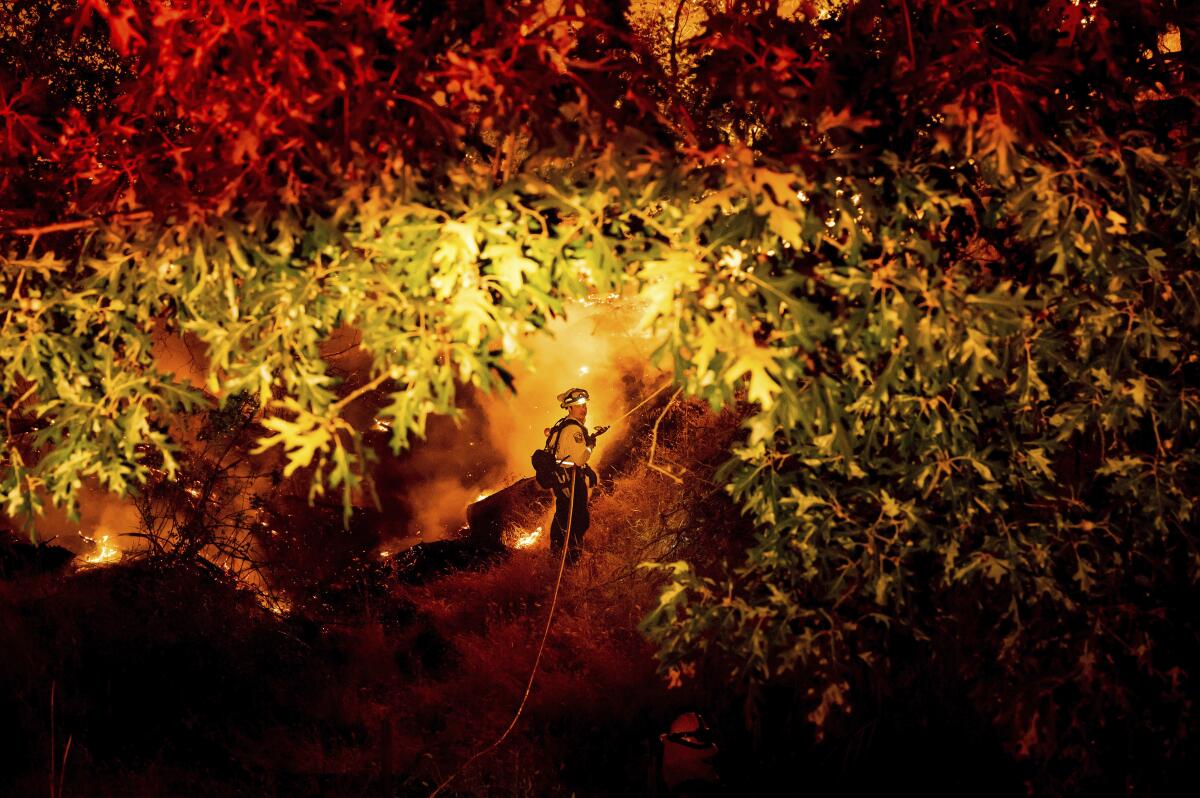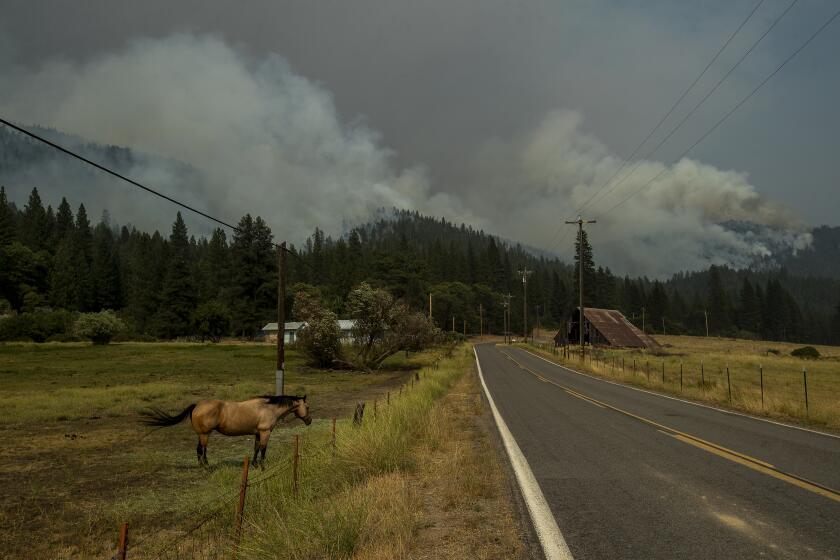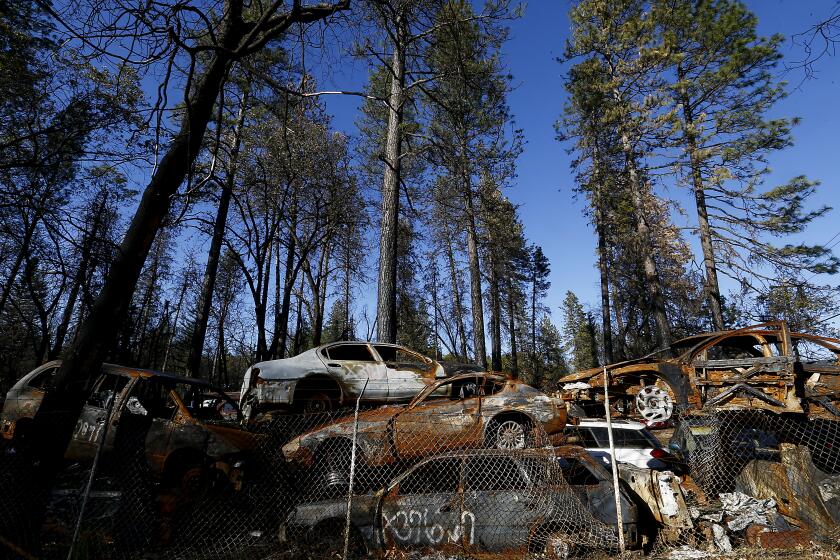Electra fire nears 4,000 acres, threatens power grid, officials say

- Share via
A fast-growing wildfire burning along the border of Amador and Calaveras counties was poised to become one of the biggest of the season as it approached 4,000 acres Tuesday, prompting evacuations and contributing to widespread power outages across the region.
The Electra fire ignited Monday afternoon near the North Fork of the Mokelumne River and spread quickly amid dry brush and steep terrain, according to the California Department of Forestry and Fire Protection.
“We’re closely watching it as it has the potential to become a large fire,” Cal Fire Battalion Chief Jon Heggie said.
By Tuesday night, the fire had burned 3,900 acres and was 5% contained, with Cal Fire officials warning that it was threatening more than 1,200 structures as well as crucial power infrastructure.
As the day wore on, Cal Fire expanded its evacuation orders and warnings to include new areas as the blaze appeared to push east from Jackson. Residents in Amador and Calaveras counties were advised to check interactive maps for the latest evacuation information.
“The Electra fire is actively burning, with short intense upslope runs,” according to a Cal Fire update Tuesday night. “Short range spotting with rollout is contributing to the fire spread. The threat to critical infrastructure is being monitored and assessed, and protection plans are being put into place.”
There were 1,334 personnel attacking the fire from the air and ground, Cal Fire said, and more support was en route. The agency said on Twitter that more than 128 engine companies, 22 water tenders, 33 bulldozers, 39 hand crews and multiple aircraft were working to establish containment lines.
Yet wildfire cameras appeared to show increasing fire activity, including thick smoke, spot fires and a large pyrocumulus cloud signaling intense heat.
“It’s smoky. From my office right now, I can see the plume looks like it’s picking up,” said Jarret Benov, operations captain with the Amador County Sheriff’s Office.
Benov said the area where the fire is burning is home to “a lot of vegetation, trees, grasses and fuels.”
“It’s a mountain community where a lot of homes are on a half-acre, an acre, and are pretty forested,” he said.
The fire is one of the largest Cal Fire has faced this year, exceeded by only the 5,800-acre Lost Lake fire that burned in Riverside County in May and the 4,100 acre Airport fire that burned in Inyo County in February, according to the agency.
Though it ignited on the Fourth of July — and amid dire warnings from California fire officials about the risks of fireworks due to severely drought-dried terrain — officials said it was too soon to speculate on the cause of the blaze.
What was more certain was that the state’s landscape was primed to burn after the driest-ever start to the year left fuel moisture levels, or the amount of moisture in the vegetation, dangerously low.
In some parts of the state, vegetation was at least four months ahead of where it should be in terms of dryness, officials announced last month.
The Northern California utility said its fire safety settings turn off power to a circuit “within one-tenth of a second” of a fault, such as a tree branch falling onto a line.
The fire was also wreaking havoc on the electric grid, with more than 12,000 customers without power Tuesday afternoon, Pacific Gas & Electric spokeswoman Megan McFarland said.
“PG&E has a number of assets potentially at risk due to the fire,” McFarland said via email.
She said PG&E was “developing restoration plans for non-impacted lines that were de-energized for firefighter safety,” which would allow the utility to restore service to some customers.
Approximately 100 people were evacuated Monday night from the Electra powerhouse, a PG&E hydropower facility near where the blaze ignited, she said.
Though the utility has faced scrutiny for its role in previous wildfires, McFarland said based on the location and timing of the fire and the subsequent power outages, “PG&E understands PG&E was not involved in the ignition.”
In response to the fire, the Red Cross opened evacuation centers at the Italian Picnic Grounds in Sutter Creek and the Mountain Oaks School, at 150 Oak St. in San Andreas. Shelters for large and small animal were also available at the Amador County Fairgrounds. An earlier shelter at the San Andreas Town Hall was closed.
The fire also prompted multiple road closures, including portions of Highways 88 and 26.
The blaze was burning not far from where the Butte fire seared through about 70,000 acres in 2015, but Cal Fire spokeswoman Diana Swart said there had been too much regrowth in the years since for its footprint to act as much of a deterrent.
“The vegetation has grown back,” she said. “That’s a very grassy area; those grasses grow back year after year, so unfortunately we don’t have a burn scar fresh enough that would really be that much of a help to us.”
The priority on Tuesday was keeping the fire east of Highway 49 and south of Highway 88, north of Jesus Maria Road and west of Highway 26 and Railroad Flat Road, she said.
The appeals court ruling could bring more accountability to the powerful agency, which has faced criticism for excessive secrecy.
Weather conditions over the fire were somewhat favorable, including relatively low winds and high humidity, said Eric Kurth, a National Weather Service meteorologist in Sacramento.
However, there were reports of fire-related smoke and air-quality issues in the San Joaquin Valley. Kurth said shifting wind patterns in the afternoon could push the smoke toward South Lake Tahoe.
Residents who see or smell smoke are advised to limit outdoor activities and use an air filter for protection.
At least one firefighter was injured battling the blaze, Swart said. She could not confirm the nature of the injury but said it was minor.
Swart said the initial report of the fire came from Highway 49 and Electra Road — a “very narrow, windy, rutty road” that leads to the PG&E powerhouse. The area is also popular for recreation because of its proximity to the river, she said.
Benov, of the Amador County Sheriff’s Office, said the frequency of wildfires in the region has increased in recent years.
“We had fires, but it wasn’t every year where you’re thinking, ‘Fire season is upon us again, here we go,’ and you have them all summer long,” he said.
Times staff writer Gregory Yee contributed to this report.
More to Read
Sign up for Essential California
The most important California stories and recommendations in your inbox every morning.
You may occasionally receive promotional content from the Los Angeles Times.













